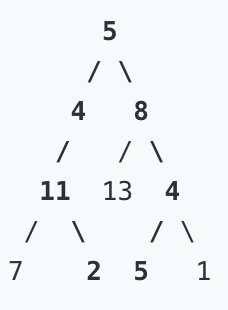(ブログ記事からの転載)
[https://leetcode.com/problems/path-sum-ii/]
Given a binary tree and a sum, find all root-to-leaf paths where each path's sum equals the given sum.
Note: A leaf is a node with no children.
Example:
Given the below binary tree and sum = 22,

Return:

前回記事の発展系で、
binary treeの先端から末端までのroot-to-leafの合計値が、変数sumの値と合致するpathを全て返す問題です。
解答・解説
解法の説明に入る前に、本問題のように経路を順に辿ってゴールするような問題の解法には、
- Depth-First Search(DFS, 深さ優先探索)
- Breadth-First Search(BFS, 幅優先探索)
の2種類があるそうです。
各々の意味と具体的な解法を示します。
解法1
私がsubmitしたIterativeな手法です。久々に一発でsubmitが通って嬉しかったです。
こちらがDFSにあたります。
treeの各rootを巡回しながら、3つの要素から成るtupleを変数stackに格納します。
1つ目の要素は現在いるroot、2つ目の要素は辿ったrootの値の合計、3つ目の要素は辿ったrootの値のリストです。
stack.pop()で、後に格納したtupleから取り出します。
取り出したtupleの2つ目の要素にrootの値を足し(と同時に3つ目の要素にrootの値をappendし)、値がsumと同値になった時点の3つ目の要素を、最終的な回答となる変数ansに格納します。
stackの後方に格納されているtupleほどtreeの深い階層にある要素になるので、stack.pop()で後に格納したtupleから取りしてwhile loopにかけるということは、より深い階層から先に探索している(=深さ優先探索をしている)ことになります。
# Definition for a binary tree node.
# class TreeNode:
# def __init__(self, x):
# self.val = x
# self.left = None
# self.right = None
class Solution:
def pathSum(self, root: TreeNode, sum: int) -> List[List[int]]:
ans = []
if not root:
return ans
stack = [(root, root.val, [root.val])]
while stack:
curr, val, path = stack.pop()
if not curr.left and not curr.right:
if val == sum:
ans.append(path)
if curr.right:
stack.append((curr.right, val+curr.right.val, path+[curr.right.val]))
if curr.left:
stack.append((curr.left, val+curr.left.val, path+[curr.left.val]))
return ans
解法2
続いてIterativeなBFS。
treeの各rootを巡回しながら、3つの要素から成るtupleを変数queueに格納します。
1つ目の要素は現在いるroot、2つ目の要素は辿ったrootの値の合計、3つ目の要素は辿ったrootの値のリストです。ここまではDFSと同じ。
DFSと異なるのは、queue.pop(0)で、先に格納したtupleから取り出すところです。
queueの前方に格納されているtupleほどtreeの浅い階層にある要素になるので、queue.pop(0)で前に格納したtupleから取りしてwhile loopにかけるということは、より浅い階層から先に探索している(=幅優先探索をしている)ことになります。
class Solution:
def pathSum(self, root: TreeNode, sum: int) -> List[List[int]]:
ans = []
if not root:
return ans
queue = [(root, root.val, [root.val])]
while queue:
curr, val, path = queue.pop(0)
if not curr.left and not curr.right:
if val == sum:
ans.append(path)
if curr.right:
queue.append((curr.right, val+curr.right.val, path+[curr.right.val]))
if curr.left:
queue.append((curr.left, val+curr.left.val, path+[curr.left.val]))
return ans
解法3
最後にRecursiveな解法は以下の通りです。考え方は前の解法に近しいので解説は省略します。
しかしなかなかRecursiveな解法を自力で完成させられません。脳がIterativeな考え方に慣れきってますね…
class Solution:
def pathSum(self, root: TreeNode, sum: int) -> List[List[int]]:
if not root:
return []
res = []
self.dfs(root, sum, [], res)
return res
def dfs(self, root, sum, ls, res):
if not root.left and not root.right and sum == root.val:
ls.append(root.val)
res.append(ls)
if root.left:
self.dfs(root.left, sum-root.val, ls+[root.val], res)
if root.right:
self.dfs(root.right, sum-root.val, ls+[root.val], res)